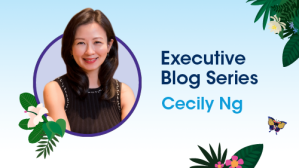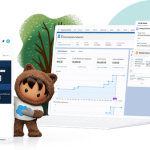Cecily Ng leads the Singapore business at Salesforce as Area Vice President and General Manager of Singapore. She is focused on enabling Singapore businesses to innovate, be more agile, and connect with their customers in a whole new way.
We all know that it’s more important than ever to be close to our customers. But what exactly does this mean? What does it look like when it’s done well?
Most organisations understand the need to get closer to their customers. It’s about providing exceptional experience and an individualised level of service.
The challenge in achieving that goal, often begins at the back end, with disparate legacy systems offering an overload of data that fail to offer the insights required to make this a reality.
Data is there, but may be hidden. It’s not always available to those on the front lines who need it, and is not being presented in a way that serves the varying needs of departments and individuals — those in sales, marketing, service, etc. — around the organisation.
Where does a business start, then? We all know it begins with knowing your customer and developing a clear understanding of your business strategy and end goal, but in today’s business environment it’s really all about the purpose and motivation of change.
Clarity that comes from developing a deep understanding of your customers’ wants and needs helps your organisation to understand why it must change. It encourages active listening and a motivation to pivot toward a customer focus. How can you make your customers’ lives as easy as possible? How do you thrill them with every interaction? Where do you want the business to be in three, four, or five years? How will customer experience have transformed when you get there?
In my experience, this is where powerful transformation begins. It’s a change of mindset that follows the recognition of the fact that we can make life better for our customers.
We went through a similar questioning of our own processes at Salesforce when the pandemic disabled our events. How can we better serve our customers when we’re such an experience-based brand? How do we bring that magic, digitally? We found a way. Our Salesforce Live: Asia online offering continues to evolve. It has now become a hugely important channel for us and our customers.
How does data help?
You already appreciate the value of data. You know it can show the way, reveal previously invisible trends, help predict future customer decisions, actions, behaviour, and so much more. The challenge in getting closer to each individual customer is that new data sets that address specific questions are required.
If we stare into an ocean of data and expect it to reveal something, we’ll never succeed. But if we approach data with a business problem that must be solved, if we have a specific question that requires an answer, we can utilise this data to reveal the information we need.
At the same time, when it comes to personalisation of services, we must ensure we take a values-based, privacy-centric approach.
Consider my own membership with Marriott Bonvoy. For purely business purposes, they never needed to know whether I was male or female. I was simply a regular guest who had particular preferences in terms of room type, bottled water, check-in times, favourite snacks , etc. For the business application, gender was irrelevant.
However, when it was time to get closer to the customer and more deeply personalise correspondence, gender absolutely did matter. If I was to receive a promotional email addressed to ‘Mr Ng’, for example, it would make me question their familiarity with me as an individual. After all, I have appeared at their front desk perhaps 50 times a year!
Fortunately for their members, Marriott Bonvoy used data to get the small details right. That’s important – for customers, little things make a big difference. I feel seen and understood by Marriott Bonvoy and their knowing who I am is a big part of the loyalty basis of our relationship.
There’s a lot of work to do to get to the point where you have that level of familiarity and where you can make the customer’s life as easy as possible. But the payoff is enormous. Brands doing this well are surprising and delighting their customers with every interaction. As they do this, they build loyalty and increase the potential value of every interaction.
How to get to know your customers
To get closer to its customers, a business must ask:
- Do our customers feel valued? How can we make them feel more valued?
- Where are our customers’ biggest pain points?
- How do customers feel about the products? Are the offerings too complicated, for example.
- What is useful knowledge for our customers and what might be considered spam?
- What matters to the customer, and what might be considered irrelevant or over-servicing?
The same analysis then must be made on the business itself.
- What information do our frontline staff require to personalise customer interactions?
- Where are the information blocks in all directions within an organisation? For example, it’s not just about frontline staff having the information they require. It’s also about whether they have a channel to feed information back into the business.
- What data do the marketing, sales, and service teams require? What information must these teams share?
- What tools do staff need to create a magical experience for customers every time?
You begin with a customer-related business problem and look to the data to find a solution. Then you ensure the relevant staff have access to that data in a live and real-time environment.
Suddenly, customers feel the business knows them a little better. More importantly, the systems in the background that drive this insight are no longer disparate. They are integrated and scalable, meaning this personalisation of service is easily scalable, too.
As a result, the business experiences an entirely new level of productivity and agility, all to the benefit of the customer.
How it feels when you’re close to your customer
AXA Singapore had a vision to become the best digital insurer by creating value and differentiation for its customers. This is a lot easier said than done.
In developing a business case, the organisation realised its operations had to be transformed.
“To holistically change how we sell, service, and engage our customers, we needed to move from a patchwork of systems to a platform approach,” said AXA Singapore’s Tomasz Kurczyk, Chief Transformation and Digital Officer.
The digital ecosystem that resulted from that transformation means AXA has a single view of each customer throughout sales, service, and marketing. Every interaction, from phone calls to email marketing messages, is deeply personalised.
Does this require more effort? Actually, it requires less. Much of the process is now automated. Errors and turnaround times have been reduced by up to 50 per cent.
Customers are noticing, too. Around 90 per cent of customers are now somewhat or very satisfied after an interaction.
Another success story is Grab, the hyperlocal services super-app. Through deep personalisation it offers customer choice, fast delivery times, value, and safety – everything its customers truly value.
Grab uses data not just to personalise its marketing, but also to drive real-time, strategic decisions within its business like improving user experience and informing app development. This, in turn, allows the business to drive improvements that continually build trust and loyalty, and that sustain communities.
Perhaps that’s where the real magic of getting close to customers is to be found, in building more than a business. When an organisation is truly close to its customers, it creates a community, a family of sorts. That’s a powerful business differentiator.
Read our customer stories and learn how businesses just like yours have succeeded in delighting their customers by using data.

























